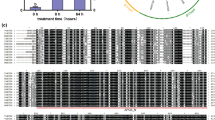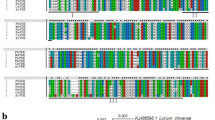Abstract
A mungbean low temperature-inducible VrPrx1 encoding 2-Cys peroxiredoxin (2-Cys Prx) was cloned by subtractive suppression hybridization. The deduced VrPrx1 amino acid sequence showed highest sequence homology to 2-Cys Prxs of Phaseolus vulgaris (95%), Pisum sativum (89%), and Arabidopsis thaliana (87%). VrPrx1 RNA and protein levels were increased by low temperature, hydrogen peroxide (H2O2), and wounding but decreased by high salinity, drought, and exogenous abscisic acid. Recombinant His-tagged VrPrx1 recombinant protein protected DNA and glutamine synthetase activity from degradation via the thiol/Fe(III) oxygen mixed-function oxidation system, and exhibited peroxidase activity to H2O2 in the presence of the reducing agent dithiothreitol (DTT) in vitro. The oxidized dimers and oligomers of the VrPrx1 recombinant protein were reduced to monomers by DTT or thioredoxin. Subcellular localization studies confirmed that VrPrx1-GFP was targeted to the plastid. To evaluate the function of VrPrx1 in planta, the antioxidant activities and photosynthetic efficiency were investigated in VrPrx1-overexpressing Arabidopsis plants. VrPrx1 ectopic expression conferred improved photosynthetic efficiency under oxidative stress conditions. Hence, mungbean VrPrx1 may play an important role in protecting the photosynthetic apparatus against oxidative and abiotic stress conditions.





Similar content being viewed by others
References
Abel S, Theologis A (1994) Transient transformation of Arabidopsis leaf protoplasts: a versatile system to study gene expression. Plant J 5:421–427
Baier M, Dietz KJ (1997) The plant 2-Cys peroxiredoxin BAS1 is a nuclear-encoded chloroplast protein: its expressional regulation, phylogenetic origin and implications for its specific physiological function in plants. Plant J 12:179–190
Baier M, Dietz KJ (1999) Protective function of chloroplast 2-cysteine peroxiredoxin in photosynthesis. Evidence from transgenic Arabidopsis. Plant Physiol 119:1407–1414
Baier M, Dietz KJ (2005) Chloroplasts as source and target of cellular redox regulation: a discussion on chloroplast redox signals in the context of plant physiology. J Exp Bot 56:1449–1462
Baier M, Noctor G, Foyer CH, Dietz KJ (2000) Antisense suppression of 2-cysteine peroxiredoxin in peroxide detoxification and its regulation. J Exp Bot 53:1321–1329
Baier M, Strőher E, Dietz KJ (2004) The acceptor availability at photosystem I and ABA control nuclear expression of 2-Cys peroxiredoxin A in Arabidopsis thaliana. Plant Cell Physiol 45:997–1006
Barranco-Medina S, Lázaro JJ, Dietz KJ (2009) The oligomeric conformation of peroxiredoxins links redox state to function. FEBS L 583:1809–1816
Bernier-Vilamor L, Navarro E, Sevilla F, Lazaro JJ (2004) Cloning and characterization of a 2-Cys peroxiredoxin from Pisum sativum. J Exp Bot 55:2191–2199
Broin M, Rey P (2003) Potato plants lacking the CDSP32 plastidic thioredoxin exhibit overoxidation of the BAS1 2-cysteine peroxiredoxin and increased lipid peroxidation in thylakoids under photooxidative stress. Plant Physiol 132:1335–1434
Broin M, Cuine S, Eymery F, Rey P (2002) The plastidic 2-cysteine peroxiredoxin is a target for a thioredoxin involved in the protection of the photosynthetic apparatus against oxidative damage. Plant Cell 14:1417–1432
Caporaletti D, D’Alessio AC, Rodriguez-Suarez RJ, Senn AM, Duek PD, Wolosiuk RA (2007) Non-reductive modulation of chloroplast fructose-1, 6-bisphosphatase by 2-Cys peroxiredoxin. Biochem Bioph Res Co 355:722–727
Chung E, Seong E, Kim YC, Chung EJ, Oh SK, Lee S, Park JM, Joung YH, Choi D (2004) A method for high frequency virus-induced gene silencing in chilli pepper (Capsicum annuum L. cv. Bukang). Mol Cells 17:377–380
Chung E, Cho C-W, Yun B-H, Choi H-K, So H-A, Lee S-W, Lee J-H (2009a) Molecular cloning and characterization of the soybean DEAD-box RNA helicase gene induced by low temperature and high salinity stress. Gene 443:91–99
Chung E, Kim K-M, Heo J-E, Cho C-W, Lee S-W, Lee J-H (2009b) Molecular characterization of mungbean peroxisomal alanine glyoxylate aminotransferase gene induced by low temperature stress. Genes Genomics 31:11–18
Church GM, Gilbert W (1984) Genomic sequencing. Proc Nat Acad Sci USA 81:1991–1995
Clough SJ, Bent AF (1998) Floral dip: a simplified method for Agrobacterium-mediated transformation of Arabidopsis thaliana. Plant J 16:735–743
Collin V, Issakidis-Bourguet E, Marchand C, Hirasawa M, Lancelin J-M, Knaff DB, Miginiac-Maslow M (2003) The Arabidopsis plastidial thioredoxins. New functions and new insights into specificity. J Biol Chem 278:23747–23752
David SJ, Vierstra RD (1996) Soluble derivatives of green fluorescent protein (GFP) for use in Arabidopsis thaliana. Weeds World 3:43–48
Dietz KJ, Jacob S, Oelze ML, Laxa M, Tognetti V, De Miranda SMN, Baier M, Finkemeier I (2006) The function of peroxiredoxins in plant organelle redox metabolism. J Exp Bot 57:1697–1709
Gao S, Yuan L, Zhai H, Liu C, He S, Liu Q (2011) Transgenic sweetpotato plants expressing an LOS5 gene are tolerant to salt stress. Plant Cell Tiss Organ Cult. doi: 10.1007/s11240-011-9971-1
Genot G, Wintz H, Houlné G, Jamet E (2001) Molecular characterization of a bean chloroplastic 2-Cys peroxiredoxin. Plant Physiol Biochem 39:449–459
Guan B, Jiang G, Wang Y, Wang Z, Haxim Y et al (2010) Identification of differentially expressed transcripts involved in the salt-stress response of Salsola ferganica by suppression subtractive hybridization. Plant Cell Tiss Organ Cult 103:343–352
Heath RL, Packer L (1968) Photoperoxidation in isolated chloroplasts. Kinetics and stoichiometry of fatty acid peroxidation. Arch Biochem Biophy 125:189–198
Horling F, König J, Dietz KJ (2002) Type II peroxiredoxin C, a member of the peroxiredoxin family of Arabidopsis thaliana: its expression and activity in comparison with other peroxiredoxins. Plan Physiol Biochem 40:491–499
Horling F, Lamkemeyer P, König J, Finkemeier I, Kandlbinder A, Baier M, Dietz KJ (2003) Divergent light-, ascorbate-, and oxidative stress-dependent regulation of expression of the peroxiredoxin gene family in Arabidopsis. Plant Physiol 13:317–325
Hu Y, Zeng Y, Guan B, Zhang F (2011) Overexpression of a vacuolar H+-pyrophosphatase and a B subunit of H+-ATPase cloned from the halophyte Halostachys capsica improves salt tolerance in Arabidopsis thaliana. Plant Cell Tiss Organ Cult. doi:10.1007/s11240-0013-9
Jin DY, Chae HZ, Rhee SG, Jeang K-T (1997) Regulatory role for a novel human thioredoxin peroxidase in NF-κB activation. J Biol Chem 272:30952–30961
Kandlbinder A, Finkemeier I, Wormuth D, Hanitzsch M, Dietz KJ (2004) The antioxidant status of photosynthesizing leaves under nutrient deficiency: redox regulation, gene expression and antioxidant activity in Arabidopsis thaliana. Physiol Plant 120:63–73
Karlin-Neumann GA, Tobin EM (1986) Transit peptides of nuclear-encoded chloroplast proteins share a common amino acid framework. EMBO J 5:9–13
Karthikeyan A, Pandian SK, Ramesh M (2011) Transgenic indica rice cv. ADT43 expressing a Δ1-pyrroline-5-carboxylate synthase (P5CS) gene from Vigna aconitifolia demonstrates salt tolerance. Plant Cell Tiss Organ Cult. doi:10.1007/s11240-011-9989-4
Khare N, Goyary D, Singh NK, Shah P, Rathore M et al (2010) Transgenic tomato cv. Pusa Uphar expressing a bacterial mannitol-1-phosphate dehydrogenase gene confers abiotic stress tolerance. Plant Cell Tiss Organ Cult 103:267–277
Kim K, Rhee SG, Stadtman ER (1985) Nonenzymatic cleavage of proteins by reactive oxygen species generated by dithiothreitol and iron. J Biol Chem 260:15394–15397
Kim K, Kim JH, Lee KY, Rhee SG, Stadtman ER (1988) The isolation and purification of a specific “protector” protein which inhibits enzyme inactivation by a thiol/Fe(III)/O2 mixed-function oxidation system. J Biol Chem 263:4704–4711
Kim KH, Alam I, Lee KW, Sharmin SA, Kwak SS, Kim KH, Lee SY, Lee BH (2010) Enhanced tolerance of transgenic tall fescue plants overexpressing 2-Cys peroxiredoxin against methyl viologen and heat stress. Biotech L 32:571–576
König J, Baier M, Horling F, Kahmann U, Harris G, Schürmann P, Dietz KJ (2002) The plant-sepcific function of 2-Cys peroxiredoxin-mediated detoxification of peroxides in the redox-hierarchy of photosynthetic electron flux. Proc Nat Acad Sci USA 99:5738–5743
König J, Lotte K, Plessow R, Brockhinke A, Baier M, Dietz KJ (2003) Reaction mechanism of the 2-Cys peroxiredoxin: role of the C-terminus and the quarternary structure. J Biol Chem 264:24409–24420
Lim YS, Cha MK, Kim HK, Uhm TB, Park JW, Kim K, Kim IH (1993) Removals of hydrogen peroxide and hydroxyl radical by thiol-specific antioxidant protein as a possible role in vivo. Biochem Bioph Res Co 192:273–280
Lokhande VH, Nikam TD, Patade VY, Ahire M, Suprasanna P (2011) Effects of optimal and supra-optimal salinity stress an antioxidant defence osmolytes and in vitro growth responses in Sesvium portulacastrum L. Plant Cell Tiss Organ Cult 104:41–49
Pérez-Ruiz JM, Spínola MC, Kirchsteiger K, Moreno J, Sahrawy M, Cejudo FJ (2006) Rice NTRC is a high-efficiency redox system for chloroplast protection against oxidative damage. Plant Cell 18:2356–2368
Pulido P, Spínola MC, Kirshsteiger K, Guinea M, Pascual MB, Sahrawy M, Sandalio LM, Dietz KJ, González M, Cejudo FJ (2010) Functional analysis of the pathways for 2-Cys peroxiredoxin reduction in Arabiodpsis thaliana chloroplasts. J Exp Bot 61:4043–4053
Rey P, Cuiné S, Eymery F, Garin J, Court M, Jacquot J-P, Rouhier N, Broin M (2005) Analysis of the proteins targeted by CDSP32, a plastidic thioredoxin participating in oxidative stress responses. Plant J 41:31–42
Rey P, Bécuwe N, Barrault M-B, Rumeau D, Havaux M, Biteau B, Toledano MB (2007) The Arabidopsis thaliana sulfiredoxin is a plastidic cysteine-sulfinic acid reductase involved in the photooxidative stress response. Plant J 49:505–514
Sakamoto A, Tsukamoto S, Yamamoto H, Ueda-Hashimoto M, Takahashi M, Suzuki H, Morikawa H (2003) Functional complementation in yeast reveals a protective role of chloroplast 2-Cys peroxiredoxin against reactive nitrogen species. Plant J 33:841–851
Sambrook J, Fritsch EF, Maniatis T (1989) Molecular cloning: a laboratory manual. 2nd edn. Cold Spring Harbor Laboratory Press, Cold Spring Harbor
Serrato AJ, Pérez-Ruiz JM, Cejudo FJ (2002) Cloning of thioredoxin h reductase system from wheat. Biochem J 217:392–399
Serrato AJ, Pérez-Ruiz JM, Spínola MC, Cejudo FJ (2004) A novel NADPH thioredoxin reductase, localized in the chloroplast, which deficiency causes hypersensitivity to abiotic stress in Arabidopsis thaliana. J Biol Chem 279:43821–43827
Thurman RG, Ley HG, Scholz R (1972) Hepatic microsomal ethanol oxidation. Hydrogen peroxide formation and the role of catalase. Eur J Biochem 25:420–430
Tripathi BN, Bhatt I, Dietz KJ (2009) Peroxiredoxins: a less studied component of hydrogen peroxide detoxification in photosynthetic organisms. Protoplasma 235:3–15
Vernon LP (1960) Spectrophotometric determination of chlorophylls and pheophytins in plant extracts. Anal Chem 32:1140–1150
Wei Q, Guo J, Cao HM, Kuai BK (2011) Cloning and characterization of an AtNHX2-like Na+/H+ antiporter gene from Ammopiptanthus mongolicus (Leguminosae) and its ectopic expression enhanced drought and salt tolerance in Arabidopsis thaliana. Plant Cell Tiss Organ Cult 105:309–316
Wood ZA, Poole LB, Hantgan RR, Karplus A (2002) Dimers to doughnuts: Redox-sensitive oligomerization of 2-cysteine peroxiredoxins. Biochem 41:5493–5504
Wood ZA, Shroder E, Harris JR, Poole LB (2003) Structure, mechanism and regulation of peroxiredoxins. Trends Biochem Sci 28:32–40
Yang KS, Kang SW, Woo HA, Hwang SC, Chae HZ, Kim K, Rhee SG (2002) Inactivation of human peroxiredoxin I during catalysis as the result of the oxidation of the catalytic site cysteine to cysteine-sulfinic acid. J Biol Chem 277:28036–38029
Zhou Y, Kok KH, Chun AC, Wong CM, Wu HW, Lin MC, Fung PC, Kung H, Jin DY (2000) Mouse peroxiredoxin V is a thioredoxin peroxidase that inhibits p53-induced apoptosis. Biochem Bioph Res Co 268:921–927
Zimmermann P, Hirsch-Hoffmann M, Henning L, Gruissem W (2004) GENEVESTIGATOR: Arabidopsis thaliana microarray database and analysis toolbox. Plant Physiol 136:2621–2632
Zok A, Oláh R, Hideg È, Horváth VG, Kós PB et al (2010) Effect of Medicago sativa ferritin gene on stress tolerance in transgenic grapevine. Plant Cell Tiss Organ Cult 100:339–344
Acknowledgments
This research was supported by the Genetic Evaluation of Important Biological Resources from National Institute of Biological Resources (NIBR, 2011), the Next-Generation BioGreen 21 Program (Plant Molecular Breeding Center No. PJ007970) of Rural Development Administration and Basic Science Research Program through the National Research Foundation of Korea (KRF) funded by the Ministry of Education, Science and Technology (KRF-2009-0068370 and -2009-0074413), Republic of Korea.
Author information
Authors and Affiliations
Corresponding author
Additional information
Chang-Woo Cho and Eunsook Chung equally contributed.
Rights and permissions
About this article
Cite this article
Cho, CW., Chung, E., Heo, JE. et al. Molecular characterization of a 2-Cys peroxiredoxin induced by abiotic stress in mungbean. Plant Cell Tiss Organ Cult 108, 473–484 (2012). https://doi.org/10.1007/s11240-011-0061-1
Received:
Accepted:
Published:
Issue Date:
DOI: https://doi.org/10.1007/s11240-011-0061-1




